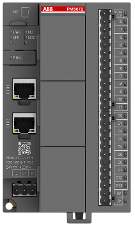Processor modules
AC500-eCo processor modules contains the CPU with the core microprocessor of the PLC. It is integrated with power supply, onboard I/Os and communication interface.
Functions of the processor modules:
-
Download the user programs.
-
Run the CPU.
-
Execute user programs in loops.
-
Monitor the program input devices and the program output devices.
Processor modules are available in different performance classes and provide different numbers of onboard I/Os.
Only one processor module is required for a valid system architecture.
Option boards
AC500-eCo processor modules can be extended with option boards. Option boards provide specific functionality. According to the processor module type, up to three option board slots are available for extension. Each option board slot supports most existing types of option board.
The option boards provide the following functionality for processor module extension:
-
Serial interface RS232 (isolated), RS485 (isolated or not isolated) and CAN (interface isolated)
-
Digital I/O channels extension (digital inputs, digital outputs, or mixed type)
-
Analog I/O channels extension (analog inputs, analog outputs) for standard signal voltage or current, but also temperature measurement with RTD/NTC or thermocouple sensors
-
RTC real-time clock board for processor module PM5012 (other processor modules include RTC functionality)
-
Configuration address switch board for KNX protocol, only for processor modules PM5072, PM5082 and PM5092
I/O modules
If the number of onboard I/Os provided on the processor module is insufficient for a certain use case, the PLC can be expanded with I/O modules to meet the control requirements.
Memory
In the PLC, the memory is mainly used for saving system programs, user programs and work data. There are two types of memory: Volatile memory and nonvolatile memory.
-
Volatile memory:
All saved data will be lost after power failure of the memory but the memory can provide a high access rate and unlimited programming cycles. Common volatile memories mainly include SRAM and DRAM (including common memories such as SDRAM).
-
Nonvolatile memory:
All saved data will not be lost after power failure of the memory, but the memory is subject to a low read-write rate and limited rewrite cycles. Common nonvolatile memories mainly include NORflash, NANDflash, EEPROM, memory card, etc.
AC500 PLCs store all user programs in the nonvolatile memory to protect them from power failure. The programs are exported to the volatile memory during PLC operation to ensure high-speed and efficient operation. If user program debugging is finished, the programs can be fixed in the nonvolatile memory when they need no change. The work data is subject to frequent change and access during PLC operation. It is saved in the volatile memory to meet the requirements for random access.
The work data memory of the PLC has the memory area for input and output relay, auxiliary relay, timer, counter and other logic devices. The state of these devices depends on initial setting and operation of the user programs. Some data maintains its existing state by using built-in supercapacitors or backup batteries in the event of a power failure. The memory area for data saving in the event of a power failure is called the data retention area.
Power supply
The PLC is equipped with a switching power supply for the internal supply. In comparison with an ordinary power supply, the switching power supply has a higher stability and a higher noise immunity.
Some modules include a stabilized power supply for the supply of external sensors.



